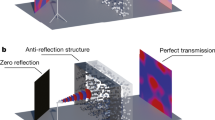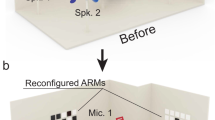Abstract
Multichannel wireless systems have become a standard solution to address our information society’s ever-increasing demand for information transfer. The capacity that such systems can achieve is ultimately limited by the channel diversity in a given propagation medium, and numerous approaches to reduce channel cross-talk by engineering software or hardware details of the signals and antenna arrays have been proposed. Here we show that optimal channel diversity can be achieved by physically shaping the propagation medium itself. Using a reconfigurable metasurface placed inside a random environment, we tune the disorder and impose perfect orthogonality of wireless channels. We report experiments in the microwave domain in which we impose equal weights of the channel matrix eigenvalues for up to 4 × 4 systems, and almost equal weights in larger systems. We also demonstrate enhanced wireless image transmission in an office room in which we augmented the 3 × 3 system’s number of effectively independent channels from two to the optimum of three.
This is a preview of subscription content, access via your institution
Access options
Access Nature and 54 other Nature Portfolio journals
Get Nature+, our best-value online-access subscription
$29.99 / 30 days
cancel any time
Subscribe to this journal
Receive 12 digital issues and online access to articles
$119.00 per year
only $9.92 per issue
Buy this article
- Purchase on Springer Link
- Instant access to full article PDF
Prices may be subject to local taxes which are calculated during checkout




Similar content being viewed by others
Data availability
The raw data used in this work are available at https://doi.org/10.5281/zenodo.1967417.
References
Shannon, C. E. A mathematical theory of communication. Bell Syst. Tech. J. 27, 379–423 (1948).
Foschini, G. J. & Gans, M. J. On limits of wireless communications in a fading environment when using multiple antennas. Wirel. Pers. Commun. 6, 311–335 (1998).
Telatar, E. Capacity of multi‐antenna Gaussian channels. Trans. Emerg. Telecommun. Technol. 10, 585–595 (1999).
Moustakas, A. L., Baranger, H. U., Balents, L., Sengupta, A. M. & Simon, S. H. Communication through a diffusive medium: Coherence and capacity. Science 287, 287–290 (2000).
Simon, S. H., Moustakas, A. L., Stoytchev, M. & Safar, H. Communication in a disordered world. Phys. Today 54, 38–43 (September, 2001).
Alamouti, S. M. A simple transmit diversity technique for wireless communications. IEEE J. Sel. Areas Commun. 16, 1451–1458 (1998).
Miller, D. A. Establishing optimal wave communication channels automatically. J. Lightwave Technol. 31, 3987–3994 (2013).
Yan, Y. et al. High-capacity millimetre-wave communications with orbital angular momentum multiplexing. Nat. Commun. 5, 4876 (2014).
Andrews, M. R., Mitra, P. P. & deCarvalho, R. Tripling the capacity of wireless communications using electromagnetic polarization. Nature 409, 316–318 (2001).
Lerosey, G., de Rosny, J., Tourin, A. & Fink, M. Focusing beyond the diffraction limit with far-field time reversal. Science 315, 1120–1122 (2007).
del Hougne, P., Rajaei, B., Daudet, L. & Lerosey, G. Intensity-only measurement of partially uncontrollable transmission matrix: demonstration with wave-field shaping in a microwave cavity. Opt. Express 24, 18631–18641 (2016).
Roy, O. & Vetterli, M. The effective rank: a measure of effective dimensionality. In 15th European Signal Process. Conf. 606–610 (EURASIP, 2007).
Kaina, N., Dupré, M., Fink, M. & Lerosey, G. Hybridized resonances to design tunable binary phase metasurface unit cells. Opt. Express 22, 18881–18888 (2014).
Sievenpiper, D., Zhang, L., Broas, R. F., Alexopolous, N. G. & Yablonovitch, E. High-impedance electromagnetic surfaces with a forbidden frequency band. IEEE Trans. Microwave Theory Tech. 47, 2059–2074 (1999).
Sihvola, A. Metamaterials in electromagnetics. Metamaterials 1, 2–11 (2007).
Tulino, A. M. & Verdú, S. Random Matrix Theory and Wireless Communications Vol. 1 (Now Publishers, Boston-Delft, 2004).
Kuhl, U., Stöckmann, H. & Weaver, R. Classical wave experiments on chaotic scattering. J. Phys. A 38, 10433 (2005).
Hemmady, S., Zheng, X., Antonsen, T. M. Jr, Ott, E. & Anlage, S. M. Universal statistics of the scattering coefficient of chaotic microwave cavities. Phys. Rev. E 71, 056215 (2005).
Dupré, M., del Hougne, P., Fink, M., Lemoult, F. & Lerosey, G. Wave-field shaping in cavities: Waves trapped in a box with controllable boundaries. Phys. Rev. Lett. 115, 017701 (2015).
Kaina, N., Dupré, M., Lerosey, G. & Fink, M. Shaping complex microwave fields in reverberating media with binary tunable metasurfaces. Sci. Rep. 4, 6693 (2014).
Ambichl, P. et al. Super-and anti-principal-modes in multimode waveguides. Phys. Rev. X 7, 041053 (2017).
Böhm, J., Brandstötter, A., Ambichl, P., Rotter, S. & Kuhl, U. In situ realization of particlelike scattering states in a microwave cavity. Phys. Rev. A. 97, 021801 (2018).
Fromenteze, T., Decroze, C. & Carsenat, D. Waveform coding for passive multiplexing: Application to microwave imaging. IEEE Trans. Antennas Propag. 63, 593–600 (2015).
Fromenteze, T., Kpré, E. L., Carsenat, D., Decroze, C. & Sakamoto, T. Single-shot compressive multiple-inputs multiple-outputs radar imaging using a two-port passive device. IEEE Access 4, 1050–1060 (2016).
Miller, D. A. Device requirements for optical interconnects to silicon chips. Proc. IEEE 97, 1166–1185 (2009).
Chang, M. F., Roychowdhury, V. P., Zhang, L., Shin, H. & Qian, Y. RF/wireless interconnect for inter-and intra-chip communications. Proc. IEEE 89, 456–466 (2001).
Phang, S. et al. Near-field MIMO communication links. IEEE Trans. Circuits Syst. I, Reg. Papers 65 , 3027–3036 (2018).
Vellekoop, I. M. & Mosk, A. P. Phase control algorithms for focusing light through turbid media. Opt. Commun. 281, 3071–3080 (2008).
Popoff, S., Lerosey, G., Fink, M., Boccara, A. C. & Gigan, S. Image transmission through an opaque material. Nat. Commun. 1, 81 (2010).
Acknowledgements
P.d.H. thanks A. Aubry and U. Kuhl for fruitful discussions. P.d.H. acknowledges funding from the French “Ministère de la Défense, Direction Générale de l’Armement”.
Author information
Authors and Affiliations
Contributions
G.L. initiated the project. P.d.H. conceived and conducted the project, and wrote the manuscript. All authors discussed the project.
Corresponding authors
Ethics declarations
Competing interests
P.d.H. declares no competing interests. G.L. and M.F. have founded and are, respectively, chief scientist and scientific advisor of Greenerwave, a company that seeks to commercialize metasurfaces, inter alia, for applications in wireless communication.
Additional information
Publisher’s note: Springer Nature remains neutral with regard to jurisdictional claims in published maps and institutional affiliations.
Supplementary information
Supplementary Information
Supplementary Discussion 1–5 and Supplementary Figures 1–7
Rights and permissions
About this article
Cite this article
del Hougne, P., Fink, M. & Lerosey, G. Optimally diverse communication channels in disordered environments with tuned randomness. Nat Electron 2, 36–41 (2019). https://doi.org/10.1038/s41928-018-0190-1
Received:
Accepted:
Published:
Issue Date:
DOI: https://doi.org/10.1038/s41928-018-0190-1
This article is cited by
-
WiFi-based non-contact human presence detection technology
Scientific Reports (2024)
-
Experimentally realized physical-model-based frugal wave control in metasurface-programmable complex media
Nature Communications (2024)
-
Optimizing multi-user indoor sound communications with acoustic reconfigurable metasurfaces
Nature Communications (2024)
-
Verification of the Effect of Local Electric Field Resonance Behaviors on the Transmission Properties of the Dual-Band Terahertz Metasurface
Journal of Electronic Materials (2023)
-
Intelligent metasurfaces: control, communication and computing
eLight (2022)



